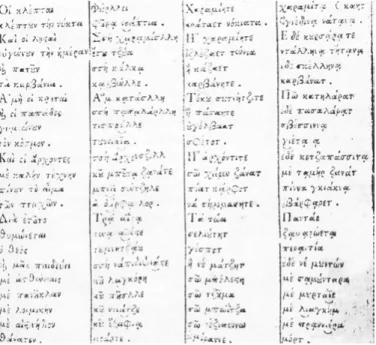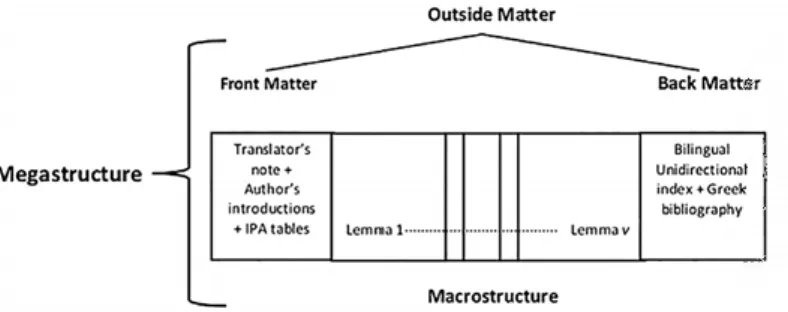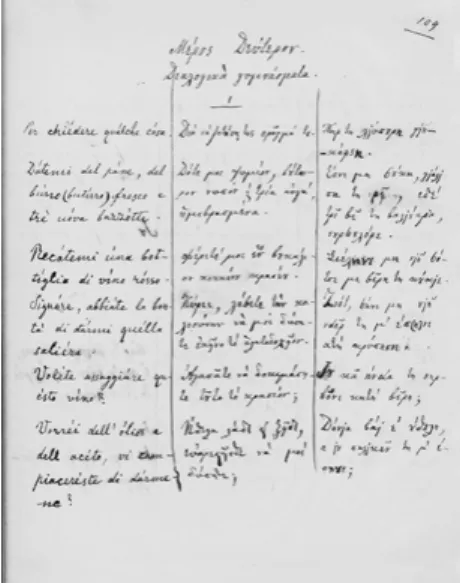A number of articles deal with historical aspects of Greek lexicography, covering all phases of the language, viz. language contact and contact-induced change in the light of the (digital) lexicography of Greek loanwords in the non-Indo-European languages of the Greco-Roman languages. worlds (Coptic, Hebrew/Aramaic, Syriac) | 21.
N. Kazazis, Classicist and Lexicographer
Griego a Ministro ti Edukasion ken CGL (digital a publikasion a magun-od iti www.greek-language.gr). Iti kapadana, isu ket nagserbi a kas ti Koordinador ti Panagsukisok idiay Sentro para iti Panag-edit ti Naipakasaritaan a Leksiko ti Griego idiay Akademia ti Atenas (1989-94) ken Direktor dagiti Bassit a Pagsasao iti Atlas Linguarum Europae (ΑLΕ).
Kriaras’ Medieval Dictionary and its importance for the study of Modern Greek
Το DictBab και το APractDict αναφέρονται μόνο στο Υστεροελληνικό radistiorion, ενώ το DictTr δεν καταγράφει τη λέξη. Στον Νεόφυτο Ροδινό (17ος αιώνας) διαβάζουμε: Με λίγο ψωμί, με λίγα χαλιά χορταίνονται οι φτωχοί, οι πεινασμένοι.'
Ο Κριαράς στην Πύλη για την Ελληνική Γλώσσα», στο: Πρακτικά του Διεθνούς Θερινού Σχολείου Επεξεργασίας Εικόνων Εγγράφων (IDIPS), 3–7 Ιουνίου 2013, Φούρνοι Κορσεών, 15–22. Κουμανούδης, Στέφανος (1980), Συλλογή νέων λέξεων που δημιούργησαν μελετητές από την άλωση της Κωνσταντινούπολης μέχρι την εποχή μας, 2η έκδ., Αθήνα.
Language contact and contact induced change in the light of the (digital) lexicography of
Greek loanwords in the non-Indo-European languages of the Greco-Roman worlds (Coptic,
Introduction
Similarly, from the point of view of historical linguistics, the areas of Egypt and Syria-Palestine were studied separately and in their own right, since the languages involved (apart from Latin) do not belong to the group of Indo-European languages, resulting in parallel, right limited accounts of comparable phenomena in Greek and in the 'other' languages. The situation in Asia Minor was different, despite the fact that the attestation of the languages in contact in this region is almost optimal.
1 Lexicography of Greek loanwords in Egyptian/Coptic
The state-of the-art: the DDGLC-Project
However, the collection and analysis (even at the most elementary level) of relevant linguistic data, i.e. since 2010, the large-scale research project Database and Dictionary of Greek-Coptic Loanwords (DDGLC)8 has established as a stated aim to provide an adequate lexicographical analysis of all loanwords included in the corpus of literary and non-literary texts of Coptic.
The “Gertrud-Bauer card index”
Nevertheless, striking data on Coptic-Greek bilingualism can already be obtained from the "parergon" of the DDGLC, namely from the material on the "inflexible" Greek loanwords in Coptic, collected by Gertrud Bauer. In a sense, the same applies to material in other languages of the Greco-Roman world and its documentation in lexicographical works.
2 Lexicography and case studies from Syria- Palestine
Greek loanwords in Jewish (Palestinian) Aramaic
The alternative form *ζητευτός, which is confirmed by many readings, is not attested in the Greek lexica, but is most likely in the view of the (poetic) form ζητεύω (=ζητέω). A rough count of the material collected in Sperber (2012) shows that there are more than three hundred new words to be added (and numerous additional forms).
Lexicography of Greek loanwords in Syriac
Many Greek loanwords entered Syriac through the extensive translation of literature from Greek into Syriac (Butts 2014a, 82);22 and many others entered Syriac through contacts between Greek speakers, Syriac speakers, and bilingual Greek-Syriac speakers. Most of the Greek loanwords in Syriac are nouns, although there are also particles and verbs.
3 Summary and outlook
Rise and Decline of the Coptic Language in Late Antique and Medieval Egypt”, in: Hanna M. eds.), From Hellenism to Islam. Shoval-Dudai, Nurit (2015), “The Integration of Greek and Latin Loanwords in Postbiblical Hebrew”, in: Scripta Classica Israelica.
Greek-Albanian and Albanian-Greek
Daniil's Tετράγλωσσον Λεξικόν, spanning pages 1–36 of the summarized text of Εἰσαγωγικὴ Διαδασκαλλασκαλλασκα, includes three hundred items. Koupitoris belong to the Albanian-speaking populations that settled centuries before in various parts of the Greek territory.

Conclusions
Skendi, Stavro (1964), «Η άνοδος των σύγχρονων λογοτεχνικών γλωσσών στα Βαλκάνια – μια συγκριτική προσέγγιση», στο: Günter Reichenkron / Alois Schmaus (επιμ.), Die Kultur Südosteuropas, ihre Geschichte und ihre Ausdrucksformen, Wiesbaden, 303– 321. 2003), «Η ελληνική ως μεταγλώσσα (η περίπτωση της «Γραμματικής της αλβανικής γλώσσας» και του «Λεξικού της αλβανικής γλώσσας» του Κ. Χριστοφορίδη)», στο: Πρακτικά 6ου Διεθνούς Συνεδρίου Ελληνικής Γλωσσολογίας. , Ρέθυμνο [ διαδικτυακά: http://www.philology.uoc.gr].
Language change and early dictionaries of Modern Greek
1 Introduction
2 Early Lexicography of Modern Greek: Meta-
Early dictionaries as a source of evidence
Pre-19th-century dictionaries of Modern Greek: How to provide Ancient Greek semantically equivalent words
Το λεξικό του Βλάχου περιέχει νέα ελληνικά λήμματα (στοιχεία και της κρητικής διαλέκτου) με λατινικές, ιταλικές και παλαιοελληνικές εξηγήσεις. Τα λεξικά του 18ου αιώνα περιλαμβάνουν, μεταξύ άλλων: (α) Ο Θησαυρός της Ρωμαϊκής και Φράγκικης Γλώσσας του Alessio da Somavera / Tesoro della lingua greca-volgare ed italiana (Παρίσι, 1709) και (β) Τρίγλωσσο Λεξικό Ιταλικής Βεντότης του Γεωργίου, Γαλλική και Ρωμαϊκή διάλεκτος [Τρίγλωσσο λεξικό Ιταλικών, Γαλλικών και Ελληνικών] (Βιέννη, 1790).
The case of the 19th-century Modern Greek lexicographical works: A system of symbols for prescriptivism
Skarlatos Vyzantios is the first Greek lexicographer who produced dictionaries in the territory of the newly free modern Greek state. 5 Due to space limitations, we consider only a selection of major Modern Greek dictionaries of this period.
3 The relationship between early lexicography and language change: Stages of change and types of
The reason is that neologisms and loanwords are incorporated to a higher degree in the Lexicon of the language in later stages of change. However, the lexicographical works seem - in contrast to grammar books - to be more affected by the social parameters of language change, as in the case of the "Greek language question".

4 Conclusions
Berg-Olsen, Sturla (2016), “Descriptive and prescriptive lexicography in the Norwegian context”, in: Tinatin Margalitadze/George Meladze (eds.), Proceedings of the XVII EURALEX International Congress. Mugglestone, Lynda (2015), “Description and Prescription in Dictionaries”, in: Philip Durkin (ed.), The Oxford Handbook of Lexicography, Oxford, 546–560.
From Plato to the Byzantine Etymologica
The etymologies of ‘ἥρωες’ in the Etymologicum Gudianum
2 Etymologicum Gudianum keessatti jalqaba epimerism itti aanu irraa kan fudhatame Homer booda (Α 4 A2):31. Alpers, Klaus (2015), "Rakkoolee Rakkoo Dabarsaa fi Walitti dhufeenya Giriikii Etymologica", in: Georgios A.
Crystal’s dictionary of linguistics and phonetics and its adaptation to Greek: lexicographic,
2 The lexicographic profile of DLP
- The nature of terminological dictionaries
- A note about linguistics terminology
- Publication history and design features of DLP
- Coverage and users
- Macrostructure
- Microstructure
The profile of the users addressed by the terminological dictionary is key to determining the technical and linguistic quality and quantity of information included in the microstructure. Because of its pedagogical nature, as Crystal himself acknowledged, the microstructure of each DLP 1st edition password was organized quite differently from what was expected for a terminological dictionary in the 1980s.
3 The Greek edition of Crystal’s DLP
- Terminology of linguistics in Greek
- Other Greek linguistics dictionaries/glossaries
- The first edition of LGF
- Building the megastructure
- Working on the macrostructure
- Working on the microstructure
- Adapting the terminology
- Translation issues
- The second edition of LGF
- A quick note on the pros and cons of the 1st edition of LGF
- From LGF1 to LGF2
The translation of DLP and the adaptation of the English linguistic terminology to Greek was not an easy task in the compilation procedure of LGF1. The presence of the visiting groen in the sentence makes a literal translation into Greek quite difficult.

4 Conclusion
Piet van Sterkenburg (ed.), A Practical Guide to Lexicography, Amsterdam Terminology: Theory, Methods and Applications, Trans. Oswald Ducrot/Tzvetan Todorov, Encyclopaedic Dictionary of the Sciences of Language, translated by Catherine Porter, Oxford 1981”, in: Journal of Linguistics.
Agamemnon
2 Existing etymologies
But the semantic motivations attributed to the name are quite neutral or even incorrect, if the name belonged to the supreme commander of the Achaean military forces: (i) 'very persistent'; (ii) 'very conscientious'; (iii) "wishing with great desire".
3 A new etymology
- Light
- Wealth
- Role in the wedding ritual
- Comparison with “bull”
- Universal king
Far above the Euripus stream a beacon light came and signaled to the watchmen on Messapion. Such are the torch-bearers I have arranged, and they pursue the course one after the other; and the winner is the one who ran first and last.
5 Conclusion
GPC = Geiriadur Prifysgol Cymru / A Dictionary of the Welsh Language,
What’s in a drop? Making sense of ΨΑΚΑΣ in Aristophanes, Acharnians 1150–1151
1 The meaning of ψακάς / ψεκάς in Ancient Greek
Let it snow with barley groats, drizzle with loaves, rain with soup. the expression of the unit 'drop' contained in 'dew' is attested by late lexicographers:5. In some passages it is difficult to determine whether the author means the continuous participle ('dew') or the singular ('drops'): 6.
2 Aristophanes, Acharnians 1150–1155 and Antimachus
And that's what they called him because he splashed his interlocutors with saliva when he spoke. And that's what they called him because he splashed his interlocutors with saliva when he spoke.
3 Did Antimachus spread an excessive amount of saliva when he talked? The linguistic evidence
Ti ebidensia iti ngato ket mangpataud kadagiti nadagsen a panagduadua maipapan ti pannakaipalawag ti patronimiko a Ψακάς iti scholia. Iti lingguistiko, ti scholia nga interpretasion ti ψακάς a kas 'drizzler' > 'sputter' ket mangipapan a nasakbay ti backformation ti berbo a ψακάζω.
4 Two problematic modern explanations
Therefore, when beauticians put it (sc. hair), they usually put and pour some water. Although Juvenal's scholia vetustiora mentions Aristophanes only once (cf. scholium ad 2.92), it is possible that Psecas' interpretation ultimately depends on the work of a scholar on the Athenian dramatist.
The combination of Hall and Geldart's emendation, the interpretation of the scholia that takes Ψακάς as Antimachus' nickname, instead of his patronymic, and Ψακάδα as a f.l. Starkie's proposal *ψακαδᾶς can be seen as a denomination similar to other formations found in late Greek: κλειδᾶς, from κλειδοποιός 'lockmaker', ὀρζςθι.
5 An alternative interpretation of Ach. 1150: drops and the smallness metaphor in Ancient Greek
Σύμφωνα με ορισμένους μελετητές, η ιδέα της ηπιότητας («η υγρασία είναι ήπια») βρίσκεται πίσω από τη χρήση των δροσών για «μικρό ζώο» (πρβλ. επίσης ἔερσαι) και προσωπικά ονόματα όπως Δρόσος και Δροσις, καθώς και άλλες οντότητες που αναφέρονται. στις παραγράφους των προηγούμενων (βλ. Bechtel Irwin. 43 Και τα μωρά των πτηνών, των φιδιών και των κροκόδειλων ονομάζονται ψάκαλοι (ή ψάκαλα;) από κάποιους, και ιδιαίτερα από τους Θεσσαλούς (Αρ.
6 Humorous patronymics in Old Comedy and Ψακάς
The absence of context can blur the comic intent of the patronymic, as in the following fragment:. By combining the patronymic Ψακάς and μελέων, Aristophanes skillfully emphasizes the object of ridicule of the entire ode.
7 Conclusion
Alonso Déniz, Alcorac (2017), « La diffusion du suffixe -(ι)άδ- dans le système dérivatif des anthroponymes féminins », i : Alcorac Alonso Déniz/Laurent Dubois/Claire Le Feuvre/Sophie Minon (red. ), Le suffiksering af oldgræske anthroponymer (SAGA). Ieranò, Giorgio (2013), « Celui qui est combattu par toutes les tribus : le poète dithyrambique et la ville d'Athènes », i : Barbara Kowalzig/Peter Wilson, Dithyramb in Context, Oxford, 368-386.
Aspects of folk etymology in Ancient Greek
Insights from common nouns
2 Folk etymology
Folk etymology: some terminological disambiguation
6 Note, however, that words produced by folk etymology do not always have a standardized form, i.e. before that time, most etymological interpretations were often impressionistic and not so rarely similar to folk etymology (cf. also [ 3] below).
Folk etymology and quasi-related phenomena
Finally, it should be noted that a more thorough theoretical-typological analysis of folk etymology (cf. e.g. an interesting classification of modern Greek forms – in phonological, morphological, semantic continua – in Fliatouras 2017) is less straightforward in the case of ancient languages : (i) there are far fewer (safe) forms in general; (ii) the data come from written texts, mostly literary, while folk etymology often thrives in oral speech (including dialectal forms); iii) etymology is often unclear and one usually has to reconstruct / guess the previous stages (cf. also Michel ii) homonym / synonym / antonym impact on the morphological / phonological / semantic value of some words: e.g. 17 Puns can of course also materialize in the form of turns of phrase etc.: e.g. a new golf war between the two famous rivals; AGk.
3 Ancient Greek etymology
Etymology in ancient Greek literature
Cyclopes 'Circle-eyed (sc. creatures, beings)' in Hesiod (Theog evidently in relation to the single circle-like eye in their forehead. On the other hand, the Stoics saw etymology - in fact the term etymology is probably a Stoic term (4. century BC) - as a means of restoring the natural correspondence between words and things by removing 'anomalies'.
4 Ancient Greek folk etymology
Proper names
- Personal names
- Place names
It is clear that arbitrary etymological analyses, puns and word games concerning personal names in ancient Greek literary texts are not part of a folk etymological study: note e.g. Ancient Greek place names also underwent a kind of morphosemantic change on several occasions as a result of folk etymology.30.
Common nouns
Note also the Latin word polypus (from an earlier Ancient Greek form πώλυπος?), even though it is not of much help in terms of the original Ancient Greek vocalism. See some interesting points in Morpurgo Davies (1986) on the formation and composition of the ancient Greek lexicon.
5 Conclusions
Brixhe, Claude (2007), “Seenaa Pristop Sodobni k Starogrškim”, v: Anastasios-Foivos Christidis (ed.), Seenaa Giriikii Durii. Haaraa, Etimološki slovar Hjalmarka Giriik, I–III, Haayidelbarg. 1998), “Εὖ, ἐύ fi Accent of Non-thematic Neuters”, v: MÍR CURAD, Qo’annoo Kabaja Calvert Watkins, qopheessaa.
Macedonian βίῤῥοξ (Hsch. B 627)
According to Hoffmann, the formation of the word must be related to forms known from Latin, such as e.g. The glosses have been cited by Hoffmann as Lesbian, on the basis of the geminate /r/ as the development of a supposed inherited */rs/ group: ἄγοῤῥι- < *agors-i- (although with some doubt; Hoffmann 1893, 228).
